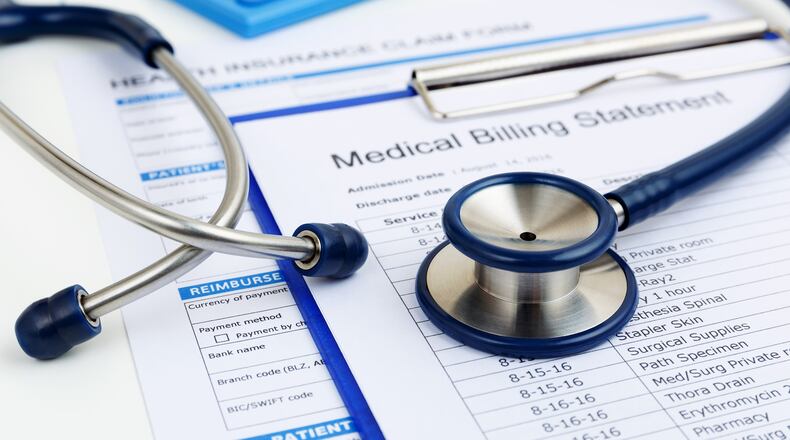Soon after giving birth to a daughter 2 months premature, Terri Logan received a bill from the hospital. She recoiled from the string of numbers separated by commas.
Logan, who was a high school math teacher in Georgia, shoved it aside and ignored subsequent bills. She was a single mom who knew she had no way to pay.
“The weight of all of that medical debt – oh man, it was tough,” Logan said. “Every day, I’m thinking about what I owe, how I’m going to get out of this … especially with the money coming in just not being enough.”
Then a few months ago – nearly 13 years after her daughter’s birth and many anxiety attacks later – Logan received some bright yellow envelopes in the mail. They were from a nonprofit group telling her it had bought and then forgiven all those past medical bills.
This time, it was a very different kind of surprise: “Wait, what? Who does that?”
RIP Medical Debt does.
The nonprofit has boomed during the COVID-19 pandemic, freeing patients of medical debt, thousands of people at a time. Its novel approach involves buying bundles of delinquent hospital bills – debts incurred by low-income patients like Logan – and then simply erasing the obligation to repay them.
It’s a model developed by two former debt collectors, Craig Antico and Jerry Ashton, who built their careers chasing down patients who couldn’t afford their bills.
“They would have conversations with people on the phone, and they would understand and have better insights into the struggles people were challenged with,” said Allison Sesso, RIP Medical Debt’s CEO. Eventually, they realized they were in a unique position to help people and switched gears from debt collection to philanthropy.
Antico and Ashton launched RIP Medical Debt in 2014. They started raising money from donors to buy up debt on secondary markets – where hospitals sell debt for pennies on the dollar to companies that profit when they collect on that debt.
RIP buys the debts just like any other collection company would – except instead of trying to profit, it sends out notices to consumers saying their debt has been cleared.
To date, RIP has purchased $6.7 billion in unpaid debt and relieved 3.6 million people of debt. The group says retiring $100 in debt costs an average of $1.
Now, RIP is expanding the pool of those eligible for relief.
With inflation and job losses stressing more families, the group now buys delinquent debt for those who make as much as four times the federal poverty level, up from twice the poverty level.
A surge in recent donations – from college students to philanthropist MacKenzie Scott, who gave $50 million in late 2020 – is fueling RIP’s expansion. That money enabled RIP to hire staff and develop software to comb through databases and identify targeted debt faster.
New regulations allow RIP to buy loans directly from hospitals, instead of just on the secondary market, expanding its access to the debt.
But RIP’s growing business, Sesso said, is nothing to celebrate. It means that millions of people have fallen victim to a U.S. insurance and health care system that’s simply too expensive and too complex for most people to navigate.
Numerous factors contribute to medical debt, and many are difficult to address: rising hospital and drug prices, high out-of-pocket costs, less generous insurance coverage, and widening racial inequalities in medical debt.
The pandemic, said Jim Branscome, a major donor, exacerbated all of that.
For Terri Logan, the former math teacher, her outstanding medical bills added to a host of other pressures in her life, which then turned into debilitating anxiety and depression.
Some hospitals say they want to alleviate that destructive cycle for their patients. Heywood Healthcare system in Massachusetts donated $800,000 of medical debt to RIP in January, essentially turning over control of that debt, in part because patients with outstanding bills were avoiding treatment.
“We wanted to eliminate at least one stressor of avoidance to get people in the doors to get the care that they need,” said Dawn Casavant, chief of philanthropy at Heywood. Plus, she said, “it’s likely that that debt would not have been collected anyway.”
One criticism of RIP’s approach has been that it isn’t preventive: The group swoops in after what can be years of financial stress and wrecked credit scores that have damaged patients’ chances of renting apartments or securing car loans. (The three major credit rating agencies recently announced changes to the way they will report medical debt, reducing its harm to credit scores to some extent.)
“A lot of damage will have been done by the time they come in to relieve that debt,” said Mark Rukavina, a program director for Community Catalyst, a consumer advocacy group.
Rukavina said state laws should force hospitals to make better use of their financial assistance programs to help patients.
To help, RIP is now advising hospitals on how to improve their internal financial systems so they better screen patients eligible for charity care – in essence, preventing people from incurring debt in the first place. Ultimately, that’s a far better outcome, Sesso said.
As for Terri Logan, she recalled how the debt shadowed her, darkening her spirits. “I don’t know; I just lost my mojo,” she said.
“But I’m kinda finding it.”
Kaiser Health News, a nonprofit health newsroom, is an editorially independent part of the Kaiser Family Foundation and is not affiliated with Kaiser Permanente.
About the Solutions Journalism Network
This story is republished through our partners at the Solutions Journalism Network, a nonprofit organization dedicated to rigorous reporting about social issues.
About the Author
Keep Reading
The Latest
Featured

